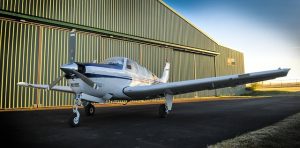
Airplanes are often designed with a variety of wing devices. Gurney flaps are among the smallest wing devices. Located on the trailing edge of an airplane’s wings, they affect air pressure. Not all airplanes have gurney flaps. Since being introduced in the early 1970s, they’ve become more common, especially among airplanes that require high lift.
Gurney Flaps Explained
Gurney flaps are tab-like devices located on the trailing edge of an airplane’s wings. They are set at a 90-degree angle to the wings. During flight, the gurney flaps will increase the air pressure on the pressure and decrease the pressure on the opposite, suction side.
They are known as “gurney flaps” because they were invented by American racecar driver Dan Gurney. At the time, gurney flaps were used exclusively in racing. It wasn’t until several years later that they were used in airplanes.
The Science Behind Gurney Flaps
Gurney flaps are similar to spoilers but for airplanes. Both gurney flaps and spoilers affect air pressure. They change the way in which air flows over and around the surfaces on which they are installed.
As wing devices, gurney flaps are installed on the wings of an airplane. They are almost always found on the trailing edge of the wings. The trailing edge, of course, is the rear. The rear or back edge of an airplane’s wings is the trailing edge. Airplanes that feature gurney flaps will have a single gurney flap on the trailing edge of each wing. The gurney flaps are flap-like devices that are set at a 90-degree angle on the trailing edge.
Gurney flaps can increase drag and lift. This makes them useful for certain specialized airplanes. Banner-towing airplanes, for instance, may feature gurney flaps. Banner-towing airplanes are small airplanes that, as the name suggests, are designed to tow banners. They don’t require powerful engines that are capable of producing fast speeds. On the contrary, banner-flying airplanes are designed to fly relatively slowly so that pedestrians and other individuals on the ground can see their banners.
Because they are set at a 90-degree angle, gurney flaps increase drag and lift. They allow banner-flying airplanes to fly more slowly while still maintaining a sufficient amount of lift. Other airplanes, as well as helicopters, may feature gurney flaps as well. Gurney flaps are small and simple wing devices that change the air pressure around them.



